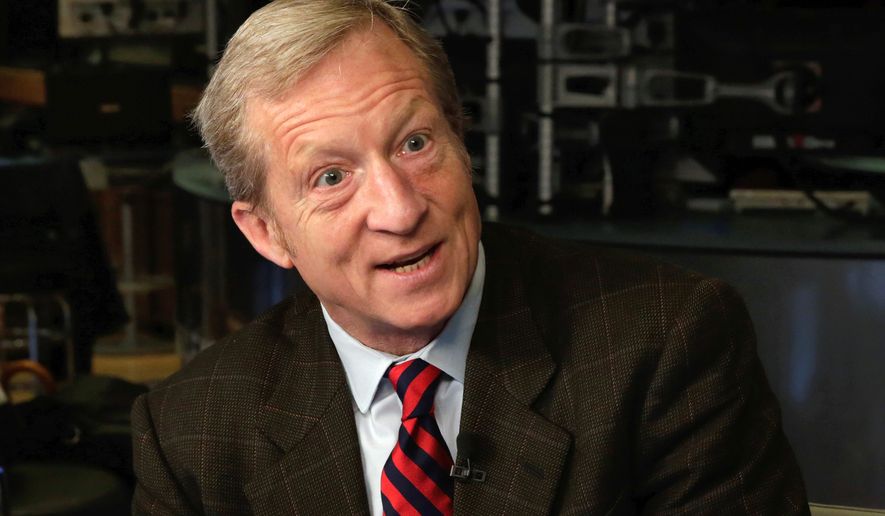Forget the blue wave, or even the red wave — this year’s election is really a green wave of cash.
Not only are the midterms setting records for campaign spending, but Democratic challengers also have broken the mold by matching or even exceeding incumbent Republicans in key races, flipping the script on the usual pattern for a party out of power.
Also adding to Democrats’ edge is a flood of “dark money,” which the party decries on the campaign trail but is boosting its prospects in some of the tightest races.
Republicans still have the biggest backer in casino magnate Sheldon Adelson, but Democrats are trying to close the gap with spending by billionaires such as Tom Steyer and Michael R. Bloomberg, according to the Center for Responsive Politics, which released a major fundraising analysis this week.
On the campaign trail, Republican lawmakers say they have been swamped by Democrats’ online fundraising prowess. Their opponents are collecting millions of dollars even in long-shot races, where the money is putting previously out-of-range seats at the fringes of the target list.
“I’ve been doing this stuff for over 30 years, and I’ve never seen it where you have incumbents getting outspent to the level they’re getting outspent,” said Jim McLaughlin, a longtime Republican operative who is working some of the most contested races this year.
A staggering amount of Democrats’ cash — $1.5 billion — was raised via ActBlue, an online portal that allows Americans to dole out small-dollar contributions to their favorite liberal candidates and organizations.
Some $250 million was raised in October alone, ActBlue announced Wednesday. Although not all of the cash goes straight to politics — some funnels to nonprofit groups — it’s a massive amount of money that the Republican Party cannot compete with.
ActBlue said nearly two-thirds of those donating through its site this election season are first-timers and that the average donation is $40.
The financial edge is likely one reason why Democrats, who had been wavering on their prospects, are once again bullish about winning the 23 seats needed to take control of the House.
“We will win, we will win, we will win,” House Minority Leader Nancy Pelosi, California Democrat, told comic Stephen Colbert on CBS’s “The Late Show” program Tuesday. “Democrats will carry the House. If we have a bigger victory, [we’ll also carry] the Senate, governorships. It’s going to be a great night for America.”
House Speaker Paul D. Ryan, who is fighting to maintain the Republican majority even as he retires, suggested that Democrats aren’t particularly popular with voters — but they are with donors.
“We don’t see a big blue wave as much as we see just a lot of money being spent against our candidates, which is obviously a challenge,” the Wisconsin Republican told radio station WVLK on Tuesday.
The Republican National Committee has trounced the Democratic National Committee in fundraising, but that is about the only advantage for the party.
The Center for Responsive Politics predicts 2017-2018 spending on national elections of more than $5.2 billion, a record “by a wide margin,” and Democrats will win the money race.
The center projects Democratic candidates, party committees, political action committees and other allies will spend an unprecedented $2.5 billion. Their Republican counterparts will spend less than $2.2 billion.
Third-party and nonpartisan organizations account for about $460 million.
Democratic candidates in the House alone have collected more than $951 million, compared with Republicans’ $637 million, the Center for Responsive Politics said.
“For the first time in a decade, Blue will outraise Red,” the analysts said.
That carries over to specific races such as Democrat Debbie Mucarsel-Powell’s attempt to oust Republican Rep. Carlos Curbelo in southern Florida.
Mr. Curbelo is no fundraising slouch, but Ms. Mucarsel-Powell and her allies have outspent Republicans in television advertising by a margin of nearly 2-to-1 — $12.3 million to $7.2 million.
Democrats are easily leading the push for small-dollar donations, defined as those less than $200, but they are also strikingly competitive at the top end, where billionaires are pouring their own cash into political action committees and other organizations.
Republican megadonor Mr. Adelson and his wife lead at $113 million, Mr. Steyer and his wife have ponied up $51 million, Mr. Bloomberg has contributed $38 million and Donald Sussman has given $23 million. Six of the top 10 on the Center for Responsive Politics’ list are Democratic donors.
“Their billionaires are much more motivated than our billionaires right now,” said Mr. McLaughlin.
One surprising change this year is a drop in what analysts call “dark money,” which is spending where the source of the contribution isn’t required to be revealed.
The Center for Responsive Politics said nearly $128 million in dark money has been spent this cycle. That is down significantly from 2014, when nearly $178 million was spent.
Political action committees are getting more money from dark-money groups, which the Center for Responsive Politics said suggests anonymous donations haven’t faded but are being funneled.
Overall, some of this year’s Senate races already top $100 million in spending. A majority of the money is coming from outside groups rather than the candidates. House races costing $20 million or more are also not uncommon.
• Seth McLaughlin contributed to this report.
• Stephen Dinan can be reached at sdinan@washingtontimes.com.




Please read our comment policy before commenting.